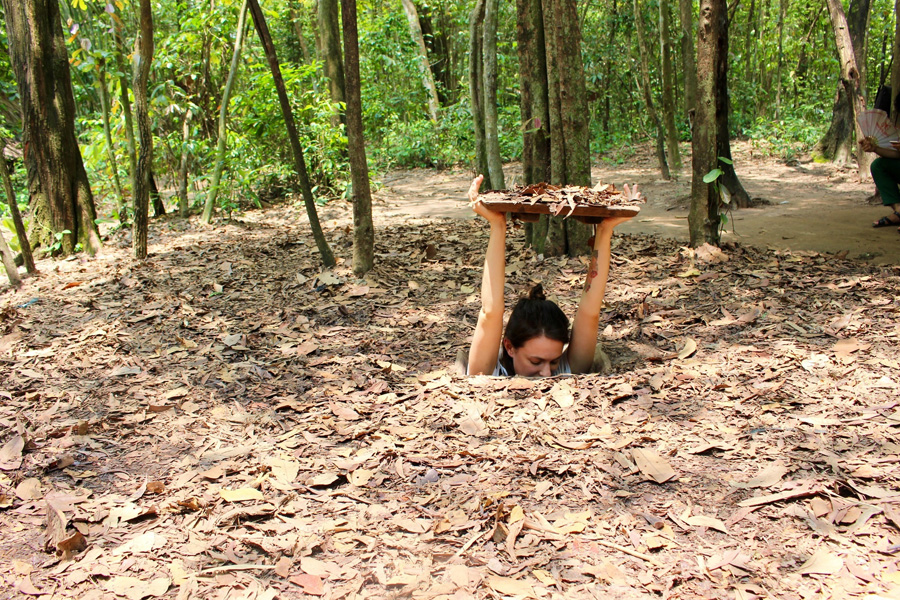The Cu Chi Tunnels are one of the best foreign tourist spots in Vietnam, representing an unsettled past of the region along with its resilient inhabitants. Located near Ho Chi Minh City, these tunnels show the self-reliance as well as the resilience of the Vietnamese troops in fighting against the American forces during the horrendous Vietnam War. The Cu Chi Tunnels create a gigantic historical vestige and a miracle of architecture that never ceased to amaze the onlookers. So if you are wondering Is the Cu Chi Tunnels worth it? then here are the answers for you.
Historical Impact of Cu Chi Tunnels
Cu Chi Tunnels rescued Vietnam War Viet Cong. Supply, housing, healthcare, and communication were given underground. The Vietnamese forces sneaked, struck suddenly, and disappeared into the underground maze. With their 250-kilometer tunnel network, the Viet Cong could withstand American forces’ superior weapons.
For huge, well-armed armies, the tunnels were too narrow. Hand-digging using small tools was widespread. This intended thinness assisted the lesser Vietnamese forces tactically. The Cu Chi Tunnels demonstrate Vietnamese resourcefulness and resilience during a tough time.
Ben Dinh vs. Ben Duoc
Ben Dinh and Ben Duoc are Cu Chi Tunnels attractions. Each offers a unique experience, so pick based on your visit.
Ben Dinh, 50 km from HCMC, is easy for tourists. Expanded tunnels make Ben Dinh’s underground network accessible. Tourists visit nearby Ben Dinh on Ho Chi Minh City tours. This place is convenient and comfortable, however the tunnels are less authentic than in Ben Duoc.
Ben Duoc, 70 km from Ho Chi Minh City, is more real and un-commercialized. The wartime Ben Duoc tunnels are preserved for visitors. Visit this secluded place for a relaxing day. Ben Duoc is great for seeing the tunnels as they were if you have time.
The Harsh Realities of Life Underground
Vietnamese soldiers fighting underground in the Cu Chi Tunnels lived harshly. The tunnels housed soldiers and civilians for days, weeks, and months. Small, gloomy, and stuffy, the area had no natural light or ventilation. Underground tunnels containing sleeping quarters, kitchens, and hospitals protected the Viet Cong from airstrikes.
The Ingenious and Deadly Booby Traps
Traps killed or injured enemy forces cleaning tunnels or approaching entrances. Traps with hidden holes, bamboo spikes, and other simple tactics enhanced harm. These traps are demonstrated and explained on underground tours. The manuals describe the traps, their creation, and their impact on enemies. These traps show how brutal the fighting was and how far Vietnamese soldiers went to defend their country.
The Cu Chi Tunnels Today: A Museum and Memorial
Visit the Cu Chi Tunnels museum and memorial to learn about the Vietnam War and the tunnels’ importance. Despite widening the tunnels for easier entry, the experience is still powerful. Battle film, Viet Cong weapons, tools, and artefacts, and guided tunnel excursions are available. It takes 45–60 minutes to tour the tunnels’ significance, construction, and history. Besides tunnels, the complex has booby traps, renovated subterranean shelters, kitchens, and hospitals. Visitors can experience tunnel fighters’ daily lives at these installations.
Conclusion
The Cu Chi Tunnels’ underground ascent is a marvel. Narrow, dark, and cramped tunnels are dangerous. Although tight, it offers a unique and exciting history experience for anyone who dare enter. Visitors can go down tunnels to simulate Vietnamese wartime conditions. Walking in dimly light environments is psychologically and physically demanding. Despite the inconvenience, many tourists consider this one of their most memorable and significant vacation events.
You may also like
-
The First Step to a Perfect Holiday: Understanding the Turkish Bath Ritual
-
Skiing: How Can a Trip Give You a New Perspective
-
Hi Road Basecamp Joins the Digital Frontier: Free Nomad Wi-Fi Coming Soon to the Mountains
-
7 Times Transportation Made or Broke a Special Event
-
Discover South Korea’s Natural Wonders One Trail at a Time: A Guide to Erik Palin’s Hiking South Korea
 The First Step to a Perfect Holiday: Understanding the Turkish Bath Ritual
The First Step to a Perfect Holiday: Understanding the Turkish Bath Ritual  Skiing: How Can a Trip Give You a New Perspective
Skiing: How Can a Trip Give You a New Perspective  Hi Road Basecamp Joins the Digital Frontier: Free Nomad Wi-Fi Coming Soon to the Mountains
Hi Road Basecamp Joins the Digital Frontier: Free Nomad Wi-Fi Coming Soon to the Mountains 

